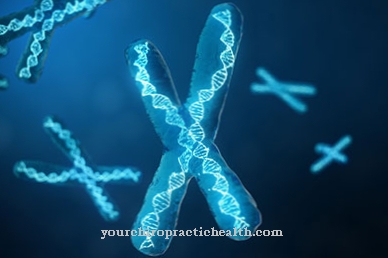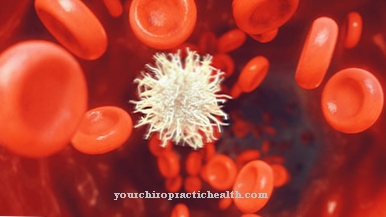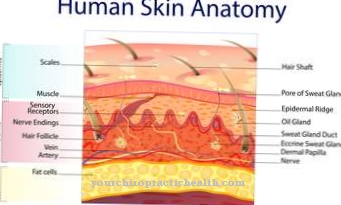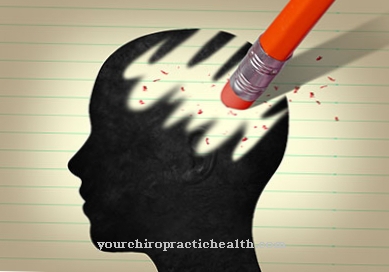At McArdle's disease it is an energy utilization disorder with a genetic cause. Those affected suffer from dark urine, muscle weakness, cramps and stiffness of the skeletal muscles. So far, McArdle's disease is incurable and is only treated symptomatically with dietary and physiotherapy therapies.
What is McArdle's disease?

© ag visuell - stock.adobe.com
McArdle's disease is also as McArdle myopathy, as McArdle disease or McArdle Syndrome known. Sometimes the energy utilization sickness is also from the Glycogen storage disease type V the speech. McArdle's disease is named after it was first described by Brian McArdle. In 1951, the pediatrician first documented a defect in alpha-glucan phosphorylase.
This is the isoform of the enzyme glycogen phosphorylase. This enzyme occurs specifically in the human skeletal muscles and is responsible for the utilization of glucose there. A genetic defect can impair the activity of glycogen phosphorylase and thus trigger a disorder of energy utilization. The body stores the energy source glucose in the muscles in the form of glycogen. The glycogen phosphorylase converts glycogen back into glucose residues. In this way, the enzyme provides the body with material to generate energy during glycolysis or the oxidative citric acid cycle. This supply process is disturbed in McArdle's disease.
causes
McArdle's disease is caused by a genetic defect and is a relatively rare hereditary disease. The genetic enzyme defect disrupts the depletion of glycogen to glucose. As a result, glycogen accumulates and the organism is no longer adequately supplied with energy. The term PGYM mutation is often used in the causal connection with McArdle's disease.
McArdle's disease is passed on as an autosomal recessive inheritance. This means that only the offspring of two carriers of the gene defect can develop the phenomenon. The probability of this is one in four with two carriers of the gene defect. But there is an equally high probability that they will have a healthy child. The probability of a symptom-free child with the genetic defect is estimated at a ratio of around two to four.
Symptoms, ailments & signs
McArdle syndrome usually manifests itself in the early years in the form of tiredness and exhaustion. Symptoms occur more frequently at the latest in young adulthood. The energy utilization disorder is most clearly noticeable in the skeletal muscles. Reduced resilience of the muscles, muscle cramps, stiffness and muscle pain are among the most common early symptoms.
Many patients also report dark urine discoloration. This discoloration is usually due to muscle breakdown products in the context of increasing muscle damage. The symptoms described mostly occur after extreme exertion or with sustained muscle exertion such as hiking.
So patients with McArdle's disease do not have to be permanently affected by the symptoms of the disease. The complaints are mostly decreasing. Often there is an improvement after around ten minutes. This improvement is related to the change in the muscles' own energy metabolism. Even short breaks often allow the symptoms to subside for the moment.
Diagnosis & course of disease
Diagnosing McArdle's disease is challenging. In the anamnestically, the stress pain of the muscles plays a role. This pain can be assessed more closely using a muscle stress test. However, they are extremely unspecific and therefore not a sufficient indication of McArdle's disease.
Serum in patients with this hereditary disease often shows an increased creatine kinase. Elevated uric acid and ammonia levels can also be pathological and suggest McArdle's disease. However, these factors are also rather unspecific and also occur in other enzyme disorders. Therefore, if McArdle's disease is suspected, a doctor will usually order a muscle biopsy. In this biopsy, the detection of glycogen deposits in the muscle fibers is considered to confirm the diagnosis.
Enzyme histochemical analysis supports the diagnosis with a non-reacting or hardly reacting phosphorylase. A PGYM mutation can be detected in molecular genetic studies. The prognosis for McArdle's disease is favorable. For example, the disease is not associated with a noticeably reduced life expectancy.
Complications
With McArdle's disease, those affected suffer in most cases from very pronounced fatigue and exhaustion. The patient's resilience also drops significantly and there is a feeling of exhaustion and, not infrequently, an exclusion from social life. Cramps also occur in the muscles and those affected appear stiff and immobile.
The muscles themselves can also hurt and lead to various restrictions in everyday life. It is not uncommon for the pain to appear at night in the form of resting pain and lead to sleep problems. Pain and swelling occur especially with heavy loads.
However, the symptoms themselves are not permanent and disappear after a short time. However, the permanent stress pain leads to a significant reduction in the patient's quality of life. However, life expectancy is not restricted by McArdle's disease.
The symptoms can be treated and limited with various therapies and training. There are no particular complications. A causal treatment of this disease is not possible.
When should you go to the doctor?
McArdle's disease, a rare glycogen storage disease, is rarely correctly diagnosed before the age of 30. The metabolic disease glycogenosis type 5 manifests itself mainly through muscle pain. These occur even with light and short exercise intensity.
These symptoms of McArdle's disease are often underestimated or misinterpreted by those affected or by doctors. Those affected often treat such muscle problems with rest or magnesium. Even if those affected go to the doctor in good time, it is often of no use to them. If the disease progresses untreated, the muscular problems increase. Cramps, myalgias or severe muscular exhaustion develop. Many muscle cells have now been destroyed by the glycogen storage problems.
So far, only symptomatic treatment of McArdle's disease has been feasible. Before exercise, a ketogenic diet can relieve symptoms. With endurance training, the individual load limit is maintained. Without special knowledge of the nature of the disease, those affected can hardly behave properly. Even with a known diagnosis and medical or physiotherapeutic treatment, more than a symptom relief can not be achieved.
Treatment & Therapy
The cause of McArdle's disease cannot yet be cured. Therefore, only symptomatic therapies are available for treatment so far. Above all, this includes a dietary approach. Patients should actively take glucose and fructose, especially shortly before or during exercise phases. This measure is usually combined with exercise therapy. Permanent muscle weakness can possibly be reduced through physiotherapeutic measures in combination with dietary measures.
In this context, the anaerobic threshold plays an important role. According to studies, endurance training below this threshold has been the most successful. The anaerobic threshold is the balance between the breakdown and production of lactate. As a therapeutic measure for McArdle's disease, endurance training should therefore take place under the maximum load intensity. In individual cases, drug therapies are also used as a therapeutic measure.
This includes, above all, the administration of low-dose creatine. This drug treatment has resulted in a significant improvement in patient performance in clinical studies. Since gene therapy has a high priority in modern research, a causal treatment option for McArdle's disease may be developed within the next few decades.
Outlook & forecast
The life expectancy of people with McArdle's disease is not restricted. As a result of the disease, in most of the cases the patients suffer from very pronounced fatigue and permanent exhaustion. Likewise, the resilience of those affected decreases significantly and there is often a feeling of exhaustion. Not infrequently this leads to a veritable exclusion from everyday social life. Cramps can also occur in the muscles, making the patient appear very stiff and unnaturally immobile. The muscles themselves can also be very painful and lead to various restrictions in the everyday life of the patient. Often times, these pains also occur during sleep at night.
In the form of resting pain, they often lead to severe sleep problems. Especially with very heavy loads, swelling and pain occur in the sick. However, these complaints are not permanent. They often disappear after a short time as if by themselves. However, the permanent stress pain in patients results in a significantly reduced quality of life.
The complaints can be treated and slowed down. This is done with the help of various therapies and special training. With McArdle's disease, there are no significant complications. However, a complete cure of the disease is not possible.
prevention
McArdle's disease cannot be prevented because it is an automatically recessive inherited disease.
Aftercare
As a rule, follow-up care for McArdle's disease proves to be relatively difficult, with very few or no special follow-up measures being available in some cases. Since it is a genetic disease, a complete cure cannot occur. Those affected should therefore have a genetic examination and advice carried out if they want to have children in order to better assess the risk of the disease being passed on to their offspring.
As a rule, those affected with this disease are dependent on the help and care of their own family, whereby loving and intensive discussions are also very important. This can prevent depression and other psychological upsets. Physiotherapy or physiotherapy are also very important to alleviate and limit the symptoms of McArdle's disease.
The person affected can repeat many exercises from such therapies in their own home and thus increase mobility. In many cases with McArdle's disease, contact with other people affected by the disease is also very useful, as this can lead to an exchange of information that makes everyday life easier for the person affected. Usually, the patient's life expectancy from this disease remains unchanged.
You can do that yourself
The focus of the therapy is on dietary measures. The patient must eat a healthy diet that is high in glucose or fructose. Especially shortly before or during physical exertion, the healing process can be positively influenced by the supply of the appropriate substances. In addition, alcohol and caffeine should be avoided. Ideally, the nutrition plan is drawn up together with the responsible doctor and a nutrition expert.
Since McArdle's disease mainly affects the muscles, exercise should be exercised. Endurance training below the anaerobic threshold can significantly improve performance. In conjunction with a creatine treatment, muscle discomfort can be effectively reduced. The other self-help measures concentrate on a healthy lifestyle with sufficient exercise, a balanced diet and avoidance of stress. Above all, physical stress should be avoided, as this can quickly worsen symptoms.
Patients who have severe muscle problems despite the above measures are best to speak to the responsible doctor. Often the creatine therapy has to be adjusted again or supplemented with other preparations. Alternative measures such as massages or acupuncture can also help in individual cases with McArdle's disease.


.jpg)


.jpg)


















.jpg)



